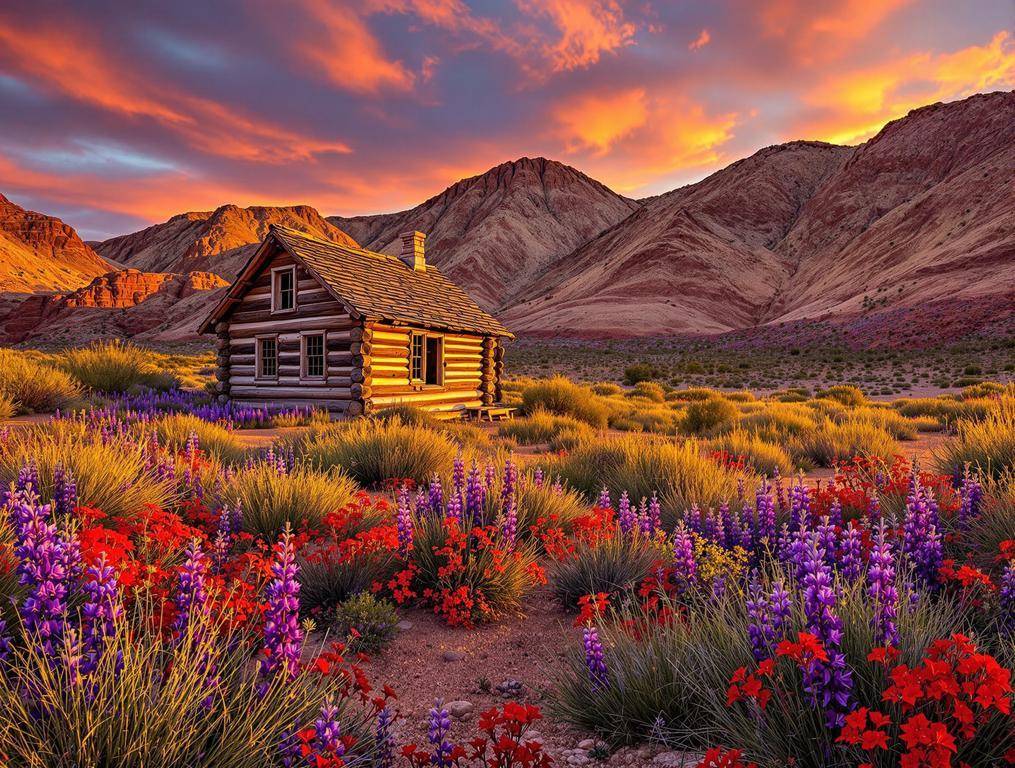The gravel road twists through Buena Vista Canyon, revealing Unionville suddenly — a collection of weathered buildings nestled against sagebrush hills. At first glance, it seems abandoned. Then I notice the smoke curling from a chimney, a garden meticulously maintained. I’ve driven 180 miles east of Reno into a living paradox: 27 people inhabit what was once a bustling mining town of 1,600 souls. And in just two weeks, this remote hamlet where Mark Twain once failed spectacularly at mining will transform into Nevada’s most spectacular wildflower showcase.
The Ghost Town Where Mark Twain Failed at Mining
I park beside the only commercial establishment in town — the Old Pioneer Garden B&B. Its owner waves from the porch, one of the 27 official residents according to the 2020 U.S. Census. Like a Western version of Brigadoon, this place exists in a strange limbo between ghost town and living community.
“Eleven cabins and a liberty pole” — that’s how Samuel Clemens described Unionville in 1862 when he arrived hoping to strike it rich. Instead, he discovered his true calling lay in writing, not mining. The cabin where he stayed still stands, its weathered logs telling a silent story about American literary history.
Originally named Dixie by Southern miners, the settlement was renamed Unionville after political tensions erupted during the Civil War. By 1863, it boasted ten stores and nine saloons. Today, those buildings are mostly gone — victims of time, abandonment, and a devastating $30,000 fire in 1872.
Every morning I walk out and feel like I’ve stepped into a painting that changes daily. People rush to Europe for this kind of beauty, but here it sits in Nevada, practically unknown. The wildflowers this July will be unlike anything we’ve seen in years.
July 2025: Peak Wildflower Season Approaching
What makes 2025 extraordinary is the combination of heavy winter snowpack and perfect spring temperatures creating optimal conditions for desert blooms. Within two weeks, the hillsides surrounding Unionville will explode with color.
The forecast calls for lupine, desert paintbrush, and penstemon to carpet the canyon in purple, red, and blue hues. Unlike California’s crowded wildflower hotspots, here you might be the only visitor on any given day. The contrast between vibrant blooms and weathered mining artifacts creates a photographer’s paradise.
While Unionville offers spectacular wildflower viewing, travelers seeking astronomical wonders can continue 186 miles east to Nevada’s remote stargazing haven, where the Milky Way appears with stunning clarity.
Beyond Virginia City: Literary History Without Crowds
Unlike Virginia City with its boardwalks filled with tourists, Unionville offers literary pilgrims something more authentic. The silence here speaks volumes. You can stand in the exact spot where America’s greatest humorist realized he was a better writer than prospector.
Unlike America’s vanishing ghost towns facing environmental threats, Unionville’s dry desert climate has preserved its structures remarkably well. The schoolhouse ruins, the cemetery, and fragments of the original Wells Fargo bank tell their stories without interpretive signs or gift shops.
Unionville joins America’s tiniest historic communities where fewer than 30 residents maintain significant historical structures against overwhelming odds. Every resident is essentially a curator of history.
What 27 Residents Maintain That 2 Million Tourists Miss
Access requires commitment — 13 miles of dirt road after turning off Highway 400. Standard vehicles can make the journey during summer months, but winter snows often isolate the town completely. Visit before October to ensure accessibility.
The Old Pioneer Garden B&B represents rural American entrepreneurship at its finest—a small business that transformed limitation into opportunity. Rooms start at $125 per night, including breakfast featuring ingredients from their garden.
While Unionville remains intentionally unrestored, other historic preservation success stories demonstrate how carefully maintained heritage can generate sustainable tourism. Yet there’s something magical about Unionville’s authentic decay.
As I drive away, the town disappears in my rearview mirror like a mirage. My daughter Emma would call this a “secret place” — too special to share widely, yet too important to forget. In a country where authentic experiences grow increasingly rare, Unionville stands as a testament to American resilience and reinvention. Mark Twain’s failure gave us his literary genius; this town’s decline preserved a perfect moment in Western history. And for two glorious weeks in July, both stories will be told amid a canvas of wildflowers that rivals any painting in any museum.
